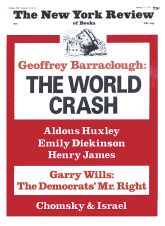In response to:
Making Black Music from the October 17, 1974 issue
To the Editors:
Charlie Parker’s instrument was the alto sax, not the tenor as Virgil Thomson noted in his review [NYR, October 17] of various books about Contemporary American Music or jazz; “Bird” also blew tenor. And a few observations I have made in the past five years of listening to music in “dingy rooms [with] half-drunk audiences”: (I also tended bar at the Village Gate and the Top of the Gate for six months in 1971). When I lived in NYC, I often went to the defunct “Slugs” on the Lower East Side; a more dingy caricature of a seamy club would be difficult to imagine. However, the audiences, usually small, were not half drunk, rather they were one of the most attentive and involved communities of people sharing a deep aesthetic and at times religious experience, with the musicians as priests and priestesses (although there are few women musicians, and the social structure of the jazz world is sexist). Usually, the audience would be 50 percent to 80 percent black. And many members of any given audience would be high on something before coming to the club(s). One Sunday evening, round about midnight, I went to “slugs” with a friend to hear a McCoy Tyner quartet. We paid an admission charge, walked ten feet into the club as the bass player, Herb Lewis (Davis?—I never got his name properly), started a solo which had the effect of (almost) stopping time. Every human in that room stopped moving as this man bowed magic: the bartender, a man about to enter the toilet, everyone stopped and for ten or fifteen minutes of ordinary time, we were all giving total attention to Herb Lewis’ music. I have spoken to many black and white people of all ages who have had similar experiences in similar “dingy” clubs around this country.
On Ben Sidran’s thesis in Black Talk: (judging from the quotations Thomson provides, this white PhD fellow has an inordinate amount of difficulties writing in English). There are other “cultures” beside “literate and oral”; some might be feeling, touching, or pure seeing cultures. That is if we accept Sidran’s criteria for defining “culture,” which I do not. I and other persons I know inhabit many cultures simultaneously, again, using Sidran’s criteria.
Richard Gordon
Santa Cruz, California
This Issue
January 23, 1975



